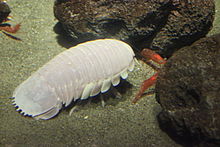Giant isopod
| Giant isopod | |
|---|---|
 |
|
| A giant isopod and shrimp | |
| Scientific classification | |
| Kingdom: | Animalia |
| Phylum: | Arthropoda |
| Subphylum: | Crustacea |
| Class: | Malacostraca |
| Order: | Isopoda |
| Suborder: | Cymothoida |
| Family: | Cirolanidae |
| Genus: |
Bathynomus A. Milne-Edwards, 1879 |
| Species | |
|
|
A giant isopod is any of the almost 20 species of large isopods (crustaceans distantly related to the shrimp and crabs, which are decapods) in the genus Bathynomus. They are abundant in cold, deep waters of the Atlantic, Pacific and Indian Oceans.Bathynomus giganteus, the species upon which the generitype is based, is often considered the largest isopod in the world, though other comparably poorly known species of Bathynomus may reach a similar size (e.g., B. kensleyi).
French zoologist Alphonse Milne-Edwards was the first to describe the genus in 1879 after his colleague Alexander Agassiz collected a juvenile male B. giganteus from the Gulf of Mexico; this was an exciting discovery for both scientists and the public, as at the time the idea of a lifeless or "azoic" deep ocean had only recently been refuted by the work of Sir Charles Wyville Thomson and others. No females were recovered until 1891.
Giant isopods are of little interest to most commercial fisheries owing to the typical scarcity of catches and because ensnared isopods are usually scavenged beyond marketability before they are recovered. The species are noted for resemblance to the common woodlouse or pill bug, to which they are related. The few specimens caught in the Americas and Japan with baited traps are sometimes seen in public aquariums.
Giant isopods are a good example of deep-sea gigantism (cf. giant squid), as they are far larger than the "typical" isopods that are up to 5 centimetres (2.0 in). Bathynomus can be divided into "giant" species where the adults generally are between 8 and 15 centimetres (3.1 and 5.9 in) long and "supergiant" species where the adults generally are between 17 and 50 centimetres (6.7 and 19.7 in). One of the "supergiants", B. giganteus, reaches an average length between 19 and 36 centimetres (7.5 and 14.2 in), with a maximum weight and length of approximately 1.7 kilograms (3.7 lb) and 76 centimetres (30 in) respectively.
...
Wikipedia
